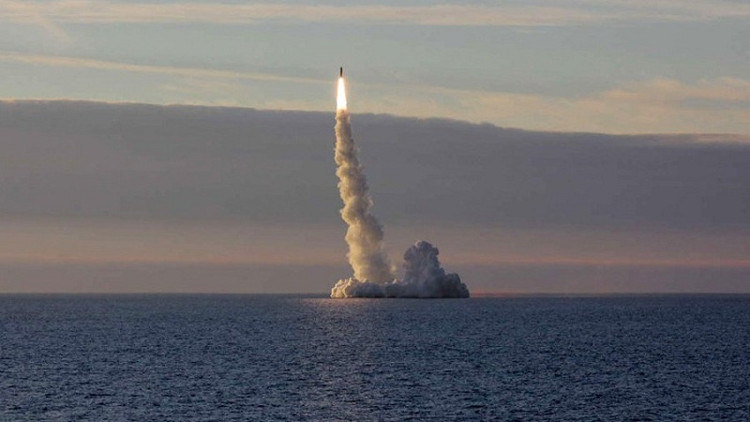Russia receives more terrible weapons than Zircon
Under the 2018 equipment plan, the Russian Army will receive a range of advanced weapons, including Skif - missiles that are even more frightening than Zircon.
Sources from the Russian Ministry of Defense said the first new weapon the force received in 2018 was referred to as the MiG-35 fighter, followed by the icebreaker Ilya Muromets, the helicopter version Mi-28UB, the ship. Yasen-M . and Skif -class nuclear submarines - missiles are even more terrifying than Zircon.
According to the public information, the Skif rocket was designed by the Marine Engineering Design Bureau Rubin in the city of Peter and the National Missile Center called Makeev in the early 1990s. Rubin was responsible for designing launchers, and the Makeev Center - the main design of the Skif missile .
This is a new type of missile, capable of being on standby for long periods of time on the seabed and then following orders to destroy targets at sea or on the ground. Skiff missile testing at the factory level was conducted by Russia in late June 2013. After that, some successful tests were done.

Russian submarine launches missiles.
Izvestia newspaper reported, to put this missile to the sea floor, Russia will use diesel-electric submarine B-90 Sarov project 20120 has been improved to carry out this task. In the bow of the Sarov submarine, a large launcher with a diameter of almost 1 m and special loading tanks were used to compensate for the weight of the missile dropped from the submarine and to help the ship maintain stability.
The source said, the layout of strategic seabed weapons has the advantage of virtually keeping the missile's location secret to enemy submarines and creating some advantage in the arms race. Nuclear.
Besides, arranging missiles with nuclear warheads on the seafloor also saves defense costs. Because the layout of missiles does not need to enhance the protection as well as equip the defense system against the enemy's attack.
It is known that in the 1970s, the United States did not consider the plan for ocean floor missiles but focused on missile launchers arranged on submarines which were well protected, could resist nuclear attack. .
In the Soviet Union in the second half of the 1980s, experts began to design the strategic weapon of the future. By the early 1990s, the Russian Ministry of Defense ordered the National Missile Center called Makeev to design this type of missile.
The design plan was kept secret and only knew that in 2005, Russia began producing the first model of a nuclear warhead missile and in 2008 conducted the first tests with the type. new weapons. In 2009, Russia continued to refine the new missile.
To deploy Skif and keep it a secret, Russia takes the following steps: The Skif submarine carries the submarine underwater to the given location and drops the missile container to the sea floor.
There is no need for any additional installation because the container will be located at the bottom of the sea. When the launch order is received, the container will pump its own compressed air and then it will be like a tumbler, which means that it will float vertically at the bottom of the sea.
Next, the gas continued to pump itself and the container began to emerge. From the point of view, missiles are launched from containers by means of a solid fuel accelerator at a depth of 50m. It was like a rocket launched from a submarine.
However, the submarine launches a missile while diving for a single purpose - not letting the enemy detect their position. In that gas, Skif is a single-use weapon, so it is more likely to use a method of launching from the surface.
With its supersonic speed and secrecy, Russia insists that once Skif is deployed, the weapon is far more frightening than the line that is also in development for the Russian Navy.
- Russia and the United States started to work on anti-meteor weapons
- Surface of the missile 'blows' the world's strongest warship
- The ultimate weapons help Russia erase the Soviet shadow
- Explore the surface of the Moon
- Russia announces information about Zircon rockets
- Russia builds 'perfect nuclear weapons'
- Life on Earth may have started over 4 billion years ago
- The most terrible weapon face in the ancient world
- The terrible disaster of space exploration
- The risk of dispersing smallpox virus through biological weapons
- Russia developed a more secret weapon than a nuclear bomb
- The Russian tsar is notorious for killing and torturing aristocrats
 'Fine laughs' - Scary and painful torture in ancient times
'Fine laughs' - Scary and painful torture in ancient times The sequence of numbers 142857 of the Egyptian pyramids is known as the strangest number in the world - Why?
The sequence of numbers 142857 of the Egyptian pyramids is known as the strangest number in the world - Why? History of the iron
History of the iron What is alum?
What is alum? Did humanity just witness its first space battle?
Did humanity just witness its first space battle?  How does the Stinger missile work?
How does the Stinger missile work?  How do hypersonic missiles work?
How do hypersonic missiles work?  Close up of the missile journey from the launch pad, move and hit the target
Close up of the missile journey from the launch pad, move and hit the target  Which Israeli naval light guard ships are equipped with advanced weapons?
Which Israeli naval light guard ships are equipped with advanced weapons?  Discover the secret bases of the Soviet Union
Discover the secret bases of the Soviet Union 